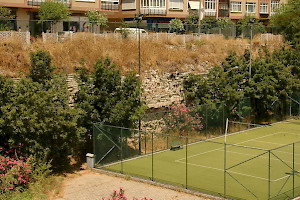Constantinople, Cistern of St Mocius
Q18210713Cistern of St Mocius: large open-air water reservoir in ancient Constantinople.
When Byzantium, renamed Constantinople, became the main imperial residence of the Roman Empire, it soon had more inhabitants than it could supply with the water of its wells and the little river west of it. So, large cisterns were built.

One of these, built by the emperor Anastasius I (r.491-518) on the Seventh Hill, was the Cistern of Saint Mocius, named after a saint who was venerated in a nearby church. It is the youngest of the great cisterns. In Turkish, it is called Altı Mermer ("the seven marbles").
It measured about 175 x 145 meters and remained uncovered (unlike, for example, the Basilica Cistern and the Topkapi Cistern). Today, it has been converted into the Fatih Educational Park, but the ancient walls are still standing. They are not really worth a detour, but if you visit the Chora Church, you're very close to the Cistern of Aetius.